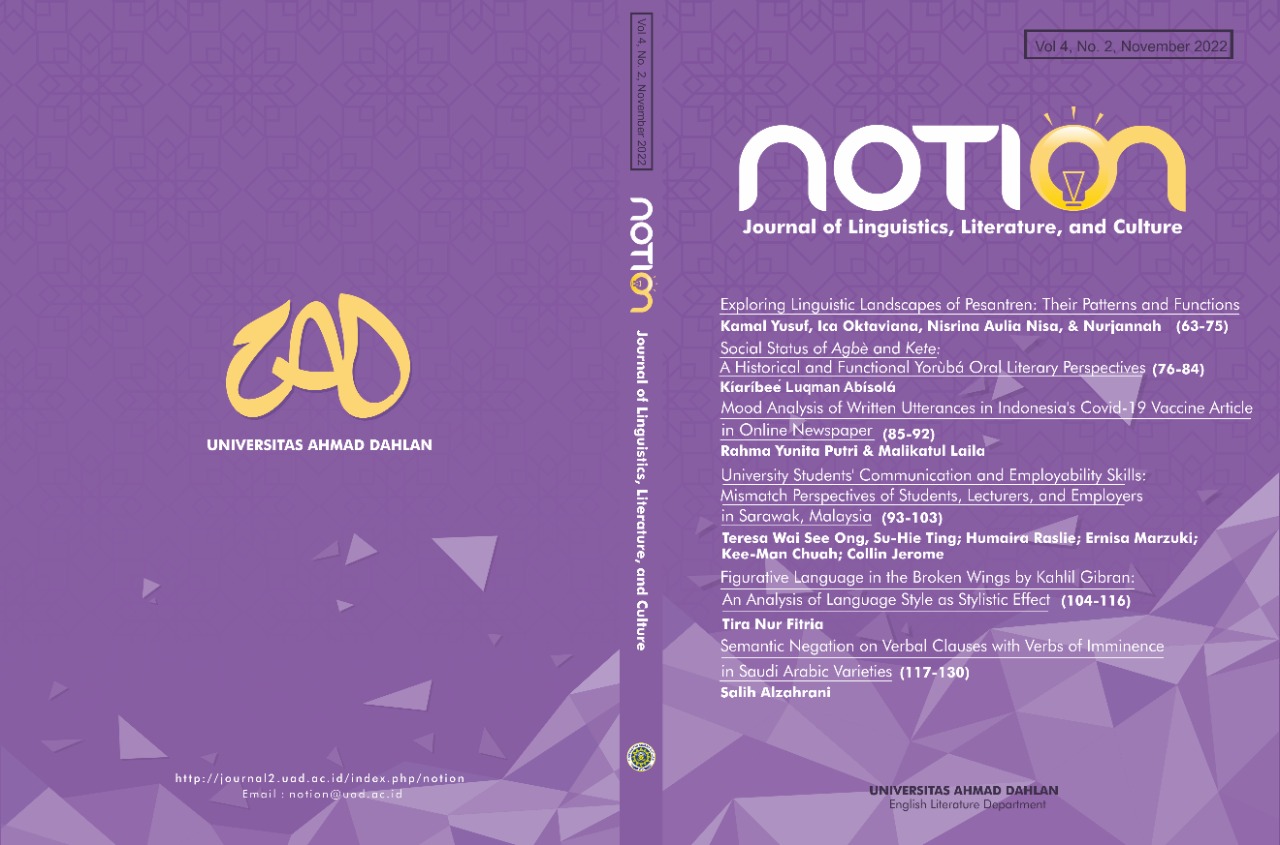Social Status of Agbè and Kete: A Historical and Functional Yorùbá Oral Literary Perspectives
DOI:
https://doi.org/10.12928/notion.v4i2.6117Keywords:
Social status , Agbè and kete, Historicism, Yorùbá oral-literary, materialsAbstract
Agbè (a gourd) and kete (a calabash pot) are both utensils in the Yorùbá socio-cultural setting. They are also made musical instruments in orin agbè and orin kete. Because both objects are structurally and functionally interwoven, many people could not delineate their status. As a result, some even take them for one. This has resulted in cultural and literary misplacement of the priority of the objects. Sequel to the identified problem, this study attempts a critical cultural and literary analysis of agbè and kete in order to validate their socio-cultural and literary status. New historicism is used as the theoretical framework. The study adopts an ethnological research design. Yorùbá oral historical and literary materials are the base of the study’s critical analysis. Data were collected among the elders in Ìbàràpá and Òkè-Ògún, and some other parts of the Yorùbáland. It is revealed in the analysis that, agbè and kete’s uses to some extent are complementary. Thus, agbè is more useful than kete. Agbè is considered for keeping precious items, and as a musical instrument, it is having social status. Kete on the hand is also having a social status as it is both used as utensil and musical instrument. However, kete’s religious status is validated for its use in Ọbàtálá religious service. Using agbè to save precious items is not enough to consider it more important than kete as kete in the religious context of Ọbàtálá is also used for a significant religious function.
References
Babagana, A. (2018). Calabash Complete, https://www.researchgate.net/publication/325989535
Ògúndèjì, P.A. (1979). “Ṣàkàrá Song in Ìṣẹmilé”, B.A. Long Essay, Department of Linguistics and African Language, University of Ìbàdàn, Ìbàdàn.
Àlàbá I. O. (1985). A Socio-Stylistic Analysis of Orin agbè: A Multimodal Genre of Yorùbá Oral Poetry, Unpublished PhD Thesis Submitted to The Department of African Languages and Literatures, Faculty of Arts, University of Lagos.
Ayedoji, H. H. (2021). Stereotype of racial issue on #starterpack. NOTION: Journal of Linguistics, Literature, and Culture, Vol 3(1), p. 44-52. https://doi.org/10.12928/notion.v3i1.3926
Ọ̀pádọ̀tun, Ọ. (2002). Okòó Ewì Alohùn, Ọ̀yọ́; Odumatt Press & Publishers.
Raji, S.M., Adéọlá, J.O, Òjó, I.F. and Táíwò, S.A. (2009). Ọ̀kan-Ò-Jọ̀kan-Ewì Alohùn Yorùbá, Ìbàdàn; Amazing Grace Computer.
Ọmọlàsóyè, L.A. (2019). “Sociological Features of the Ìlọrin Yorùbá Indigenous Oral Genres”, Doctor of Philosophy Thesis, Department of Linguistics and African Languages, University of Ibadan, Ibadan.
Tur, A. P. A. & Sari, F. A. Reshaping the society face through the culture of horror told in Shirley Jackson’s the lottery. Notion: Journal of Linguistics, Literature, and Culture, Vol. 1(1), p. 1-7. https://doi.org/10.12928/notion.v1i1.709
Williams, B. and Rily, M. (2018). “The Challenges of Oral History to Environmental History” in Environment and History, pp 1-34, https://www.researchgate.net/publication/323523645
Fatha, N., Adam, M., Manaku, R. A., & Tangkilisan, S. (2021). Cultural appropriation of Polynesian portrayed in Moana movie. NOTION: Journal of Linguistics, Literature, and Culture, Vol 3(2), p. 92-98. https://doi.org/10.12928/notion.v3i2.4885
Ọlápọ̀jù, F.R. (2022). “A Structuralist Study of Ṣẹ́kẹ́rẹ́modò Royal Song in Ilé-Ifẹ̀”, a Master of Art Dissertation, Linguistics and African Studies, University of Ìbàdàn.
Okediji, H.A. A. (2017). “Effect of Oral Traditions, Folklores and History on the Development of Education in Nigeria, 1977 Till Date” in History Research, vol. 7, no. 2, pp 59-72, https://www.doi.org/10.17265/2159-550X/2017.2.001
Nathaniel, O. S., Mogu, F.I. and Akpagu, W.Z. (2006). “A New Historicist Analysis of Lorraine Hanberry’s A Raisin in the Sun and Adrienne Kennedy’s Funnyhouse of a Negro” in Journal of Contemporary Research, 13 (2), 72-86, ISSN: 1813-222, https://www.researchgate.net/publication/33658706
Lyu, X. (2021). “An Introduction to New Historicism” in Advances in Social Science, Education and Humanities Research, vol. 543, Proceedings of the 2021, 6th International Conference on Social Sciences and Economic Development (ICSSED 2021), pp. 1075-1078.
Hicking, M. (2018). “New Historicism” in Brock Education Journal, 27 (2),53-57, mh160k@brocku.ca
Samuel, K. (2012). “Dùndún Drumming in Yorùbáland” in Journal of Performance Arts, vol. 4, no. 3, pp. 129-144, https://www.researchgate.net/publication/31756370_dundun_drumming_in_Yorubaland
Evans, M. A. (2020). Black and white propaganda triggering the war in Afghanistan. NOTION: Journal of Linguistics, Literature, and Culture, Vol. 2(2), p. 80-89. https://doi.org/10.12928/notion.v2i2.2862
Downloads
Published
Issue
Section
License
Copyright (c) 2022 Kíaríbẹ̀ẹ́ Luqman Abísọ́lá

This work is licensed under a Creative Commons Attribution 4.0 International License.
Authors who publish their articles in NOTION: journal of Linguistics, Literature, and Culture agree to the following terms:
- Authors retain the copyright and grant the journal right of first publication with the work simultaneously licensed under a Creative Commons Attribution 4.0 International License that allows others to share the work with an acknowledgement of the work's authorship and initial publication in this journal.
- Authors are able to enter into separate, additional contractual arrangements for the non-exclusive distribution of the journal's published version of the work (e.g., post it to an institutional repository or publish it in a book), with an acknowledgement of its initial publication in this journal.
- Authors are permitted and encouraged to post their work online (e.g., in institutional repositories or on their website) prior to and during the submission process, as it can lead to productive exchanges, as well as earlier and greater citation of published work.





